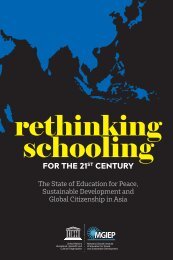Industry Guidelines on Digital Learning: Discussion Draft
The guidelines offered in this document are a first draft to provide a holistic system of characteristics and parameters important for delivering active and engaging learning through digital solutions.
The guidelines offered in this document are a first draft to provide a holistic system of characteristics and parameters important for delivering active and engaging learning through digital solutions.
You also want an ePaper? Increase the reach of your titles
YUMPU automatically turns print PDFs into web optimized ePapers that Google loves.
ii. CRITICAL THINKING<br />
Critical thinking can be defined as “the intellectually disciplined<br />
process of actively and skillfully c<strong>on</strong>ceptualizing, applying, analyzing,<br />
synthesizing, and/or evaluating informati<strong>on</strong> gathered from, or<br />
generated by, observati<strong>on</strong>, experience, reflecti<strong>on</strong>, reas<strong>on</strong>ing, or<br />
communicati<strong>on</strong>, as a guide to belief and acti<strong>on</strong>.”<br />
In essence, critical thinking refers to questi<strong>on</strong>ing claims, rather than<br />
accepting them at face value, which is particularly useful for problem<br />
solving, decisi<strong>on</strong> making, researching, effective reas<strong>on</strong>ing and systems<br />
thinking.<br />
B. Skills (what you do with what you know)<br />
i. CREATIVITY<br />
Creativity is a complex c<strong>on</strong>struct and has been defined as the act of<br />
turning new and imaginative ideas into reality or the tendency to solve<br />
problems or create new things in a unique way. It is characterized by<br />
the ability to perceive the world in new ways, to find hidden patterns, to<br />
make c<strong>on</strong>necti<strong>on</strong>s between seemingly disparate phenomena, and to<br />
generate soluti<strong>on</strong>s.<br />
Teaching and training critical thinking can be achieved in very different<br />
manners, e.g. by projects that involve interpreting informati<strong>on</strong>,<br />
analyzing parts and wholes, analysis and synthesis, evaluating<br />
evidence, taking multiple perspectives, discerning patterns, and<br />
grasping abstract ideas. ,<br />
<strong>Digital</strong> learning applicati<strong>on</strong>s should include experiences, opportunities<br />
and exercises which require the learner to think critically<br />
Research indicates that such c<strong>on</strong>necti<strong>on</strong>s can be accomplished by<br />
cultivating divergent thinking skills and deliberately exposing <strong>on</strong>eself<br />
to new experiences and to learning.<br />
<strong>Digital</strong> learning applicati<strong>on</strong>s should adopt approaches that enhance<br />
creative thinking, such as problem-based or project-based learning<br />
methods<br />
FOREWORD | INTRODUCTION | GUIDELINES | CONCLUSION | AUTHORS & REVIEWERS | REFERENCES<br />
PURPOSE | PRINCIPLES | STRUCTURE | MANDATORY GUIDELINES | RECOMMENDED GUIDELINES<br />
PURPOSE | PRINCIPLES | STRUCTURE | MANDATORY GUIDELINES | RECOMMENDED GUIDELINES


















